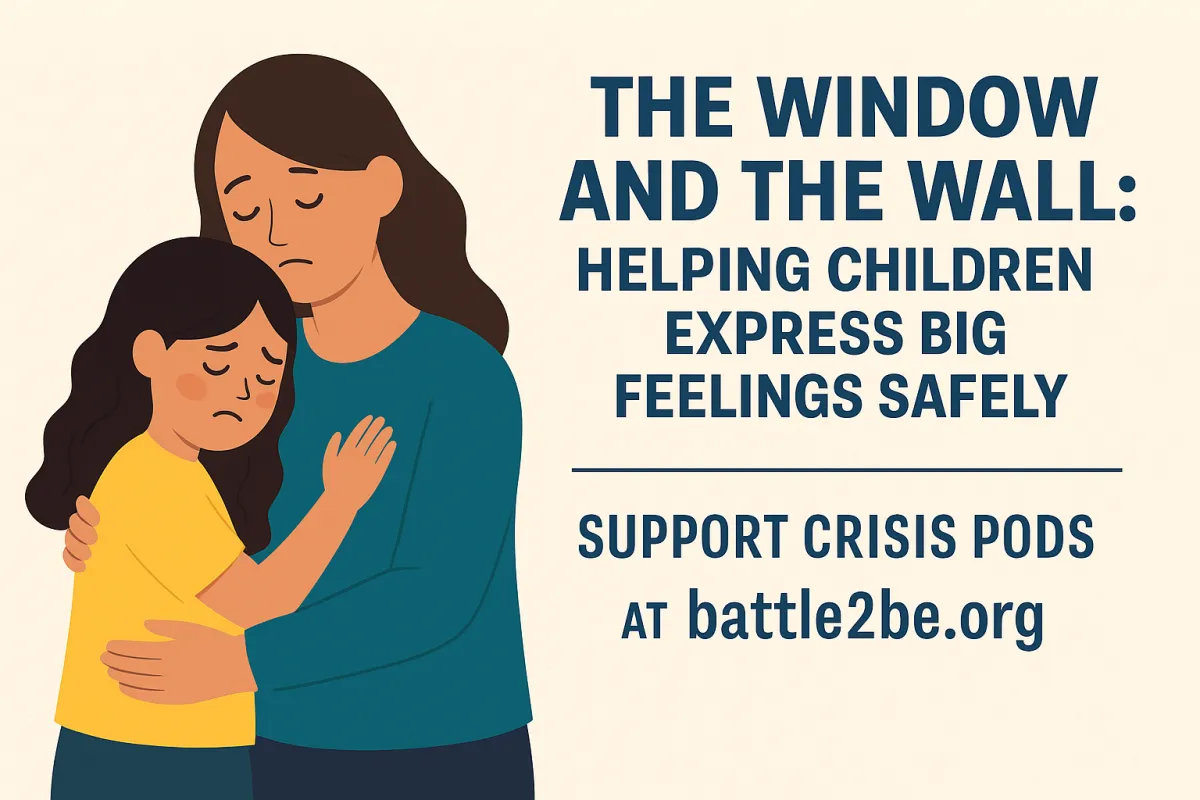
Building Blocks-The Window and The Wall
The Window and the Wall: Helping Children Express Big Feelings Safely
By Krista Fee | RISEUP: Voices From the Frontlines | KIDSAFE™ Series
When a child melts down, shuts down, or lashes out, most adults instinctively react—correct the behavior, stop the chaos, restore order.
But here’s the truth: the goal isn’t to stop the emotion. It’s to create safety inside it.
In this episode of RISEUP: Voices From the Frontlines, we explore a vital concept for anyone raising, teaching, or working with children: how to be the window when their world feels like a wall.
The Child’s Nervous System Under Stress
Let’s start with the science.
A child’s brain is still developing—especially the prefrontal cortex, which is responsible for emotional regulation, impulse control, and reasoning. Meanwhile, the amygdala—the brain’s fear center—is already fully online and highly reactive.
So when a child hears yelling, senses tension, or feels misunderstood, their brain processes it as danger. That activates a fight, flight, freeze, or fawn response.
Fight: yelling, hitting, throwing
Flight: running away, hiding
Freeze: shutting down, going silent
Fawn: people-pleasing, over-compliance
These are not bad behaviors. They are biological responses from a nervous system in distress.
The Wall vs. The Window
When a child is dysregulated, what they need most is co-regulation—a calm, grounded adult to anchor them through the storm.
The Wall is the adult who shames, yells, punishes, or disconnects.
The Window is the adult who stays emotionally available and safe, even when the child isn’t.
Being a window doesn’t mean you allow harmful behavior. It means you lead with connection before correction—because true discipline means to teach, not to punish.
5 Tools to Help Kids Navigate Big Emotions
Here are five trauma-informed tools to help children feel, name, and move through their emotions—without getting stuck in them.
1. Name It to Tame It
When you name a feeling, it activates the child’s prefrontal cortex and helps them shift out of survival mode.
Try this:
“It looks like your body is really mad right now. I wonder if it’s because you didn’t feel heard?”
IFS language tip:
Say, “Is there a part of you that’s feeling angry?” This teaches children their feelings are parts of them—not all of them.
2. Co-Regulate With Your Body
Children respond more to your nervous system than your words.
Try this:
Slow your breathing. Lower your voice. Offer a hand and say, “Let’s take three deep breaths together.” Even if they resist, your calm state is the regulation they need to borrow.
3. Validate Before You Redirect
Emotional safety comes first. Validation helps a child feel seen and lowers their defenses.
Try this:
“It makes sense that you feel upset. That was really overwhelming.” Then invite a different behavior.
This teaches: Your feelings are allowed. Your behavior is guidable.
4. Create Emotional Outlets
Not all kids process feelings through words. Use art, movement, music, and play to help them express.
Try this:
“Want to draw what your mad looks like?” or “Let’s stomp out the grumpy together.”
These rituals become emotional blueprints they’ll carry for life.
5. Build the Bridge Back to Safety
Once calm returns, revisit what happened with curiosity—not shame.
Try this:
“What helped you calm down? What should we try next time?”
This builds emotional literacy and teaches that even big feelings have a beginning, middle, and end.
You Don’t Have to Be Perfect—Just Present
Being the window doesn’t mean you never get frustrated or overwhelmed. It means you come back. You model repair. You lead with empathy and regulation—not just rules.
And most of all, you help the child build internal windows—emotional tools they’ll use long after you’re gone.
👩🏫 JOIN THE RISEUP BUILDING BLOCKS KIDS™ COMMUNITY
We created the Building Blocks Kids™ community to support parents, teachers, and child-focused professionals with science-backed tools to help kids grow regulated, confident, and connected.
Your membership includes:
Expert-led courses on resilience and child development
CEU-eligible trainings on bullying, suicide prevention, and crisis response
Trauma-informed tools for home, classroom, and care settings
Group coaching and access to certified mentors
🧭 Register now → https://calendly.com/riseupphoenix/connect
🤝 SPONSOR WITH PURPOSE
Are you a business, leader, or organization committed to child safety and emotional wellbeing?
We’re currently seeking aligned sponsors to support the RISEUP: Voices From the Frontlines podcast and our KIDSAFE™ education initiatives.
Sponsorship directly funds:
Trauma-informed education and outreach
Crisis preparation and response training
The expansion of our mobile Crisis Pods in high-need communities
📩 Request a sponsorship packet → battle2be.org
🌍 SUPPORT OUR CRISIS PODS
Crisis Pods are more than supply kits. They’re relationship tools.
Each mobile unit includes:
Food, water, and medical essentials
Emotional first aid kits for children and families
Pre-crisis education materials for schools and responders
We’re raising $50,000 to deploy the next wave of Crisis Pods in Texas and Chicago.
🔗 Donate: BATTLE2BE
Children don’t need perfection. They need presence.
Be the window they can see hope through.
🎧 Listen to the full episode → https://feeds.megaphone.fm/HERML4183537849
🏷 Tag and share: #KIDSAFE #RISEUPVoices #BuildingBlocksKids #EmotionalSafety #TraumaInformedParenting #TheWindowAndTheWall
